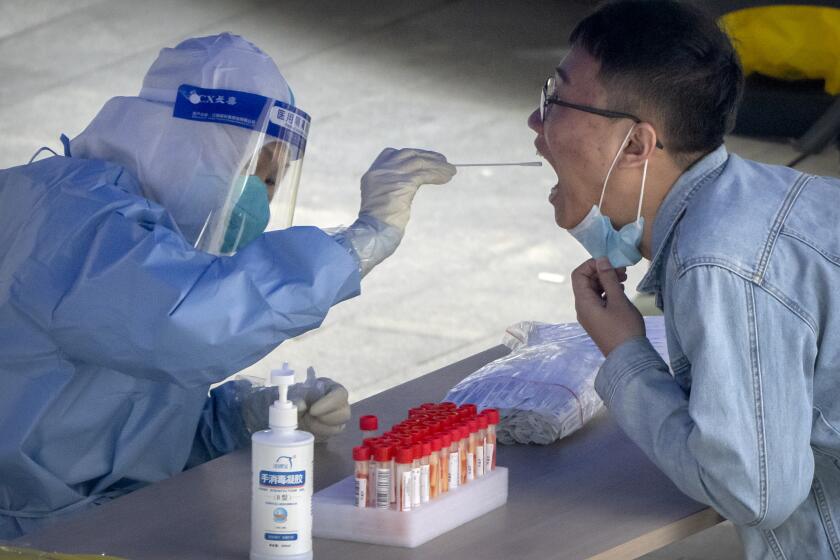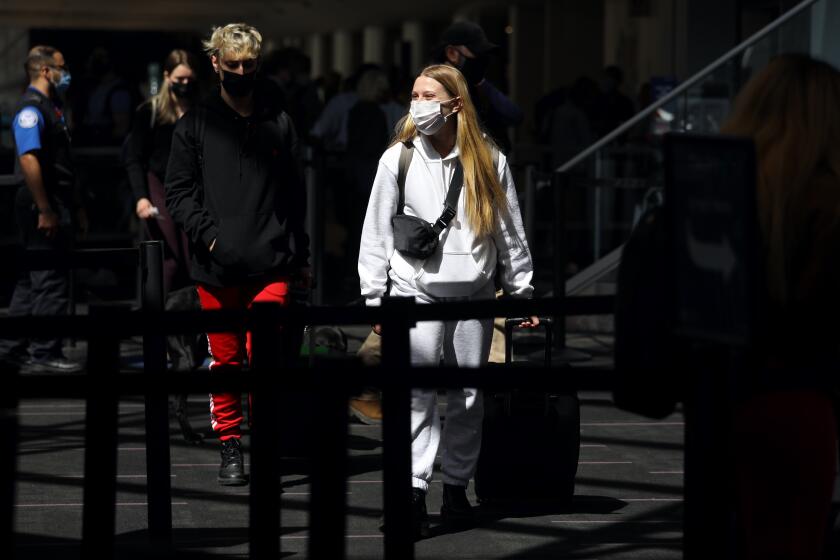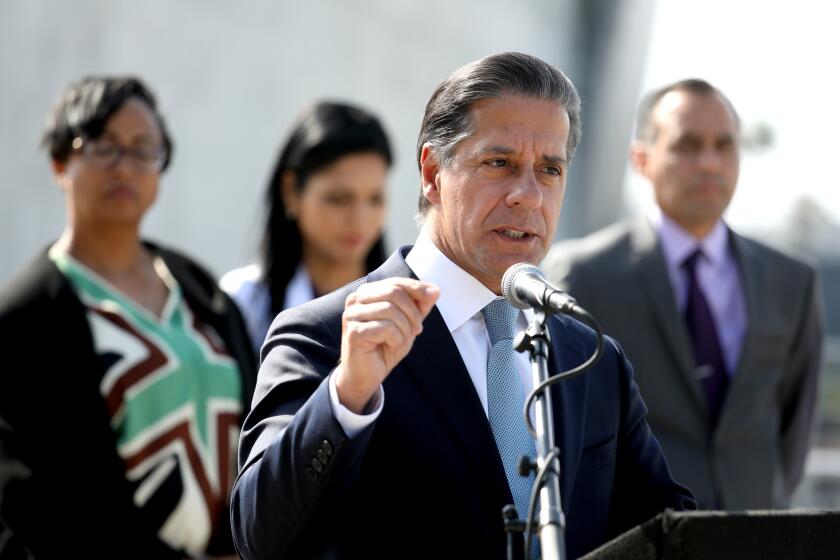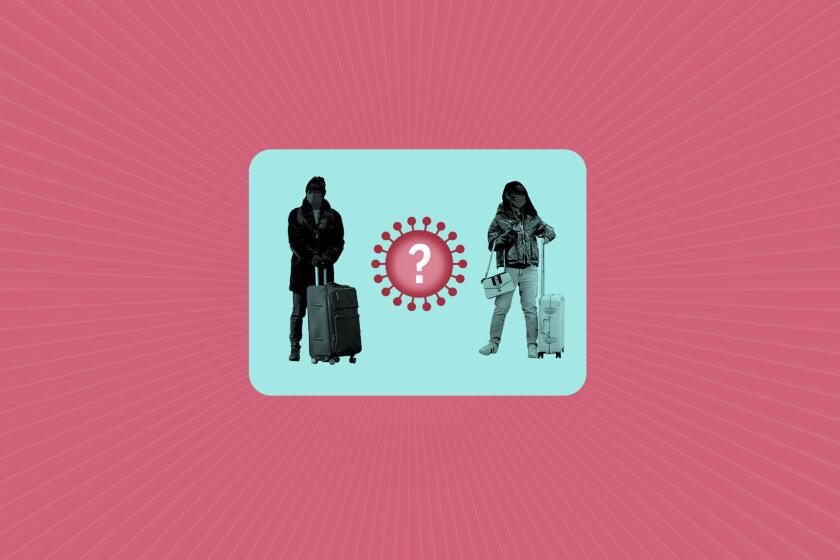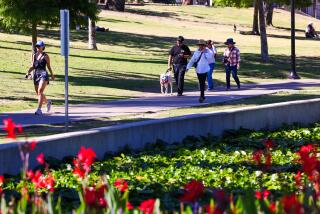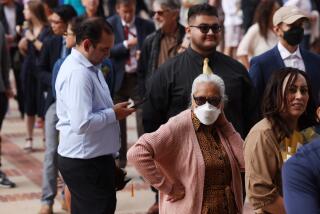L.A. County workplaces and schools seeing rising coronavirus cases
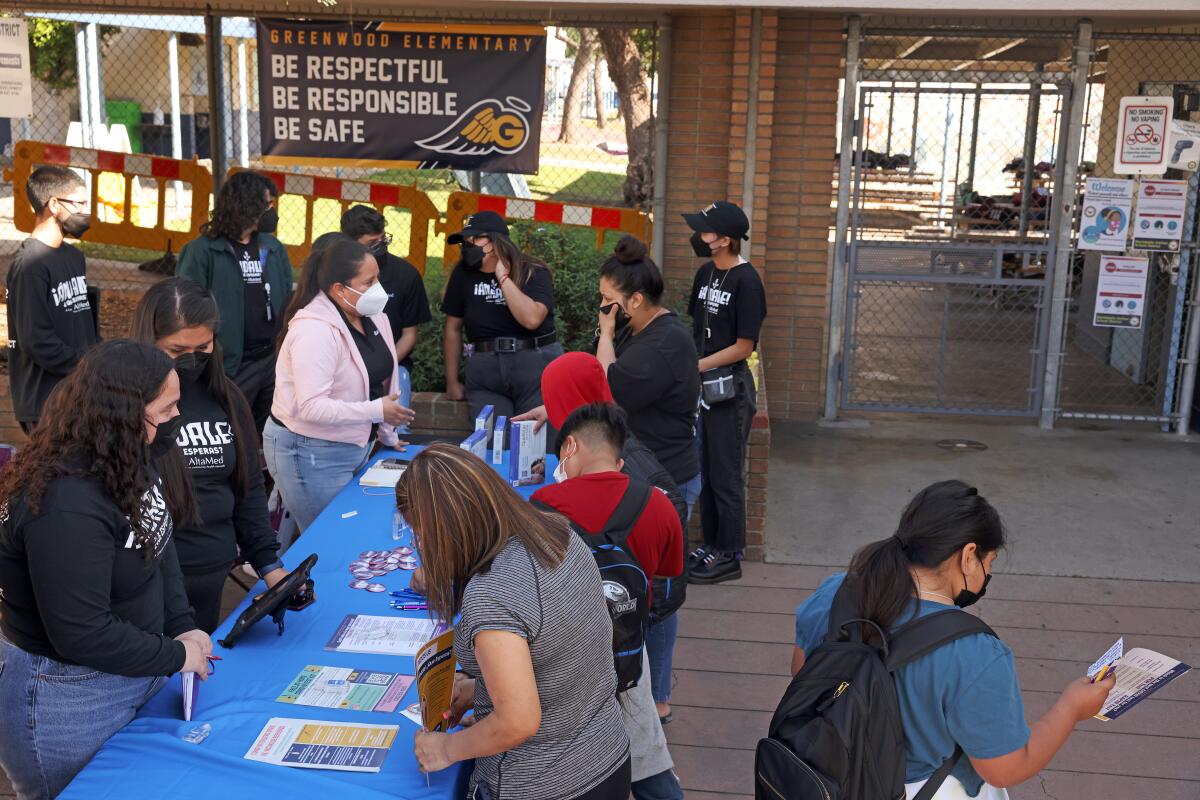
Coronavirus cases are on the rise in Los Angeles County workplaces and schools, underscoring the need to take additional precautions to prevent outbreaks, officials said.
The infections documented in these settings reflect what’s been a steady, weekslong increase in coronavirus activity countywide. But officials say schools and workplaces can be at higher risk of transmission because they are typically places where people gather indoors in close proximity for hours at a time.
“Businesses, schools, healthcare facilities and other organizations continue to play a key role in promoting safety,” county Public Health Director Barbara Ferrer said Wednesday. “However, as we’ve learned from our experience, we have a better chance of preventing tragic outcomes when we slow the spread.”
The county has established an early alert framework for coronavirus transmission that assesses a number of metrics and classifies them as being of low, medium or high concern. Health officials now consider the number of clusters at workplaces and outbreaks at schools to be of medium concern.
Coronavirus cases continue to rise in California, prompting one health official to say the state is heading into the next wave of the pandemic.
Countywide, 108 worksites reported new clusters of coronavirus cases in the last week, up from 82 the prior week. The number of weekly K-12 outbreaks doubled over the same period, from six to 13.
The number of reported coronavirus cases among K-12 students and staff has more than quadrupled in the last month, according to Ferrer. About 300 elementary school students and staff in L.A. County had a positive coronavirus test between March 21 and 27, but that figure rose to about 1,200 between April 18 and 24.
“There are now nearly as many cases among students and staff as there were in mid-February,” Ferrer said, an increase likely fueled at least in part by travel over spring break.
And, she continued, “with lots of end-of-the-year events happening, we will continue to see additional increases unless there’s a very big difference in the amount of protection that individual people are taking.”
Overall, the average number of new coronavirus infections being reported daily in L.A. County has risen 29% since last week — from 1,835 to 2,366.
On a per capita basis, L.A. County is now tallying 164 cases a week for every 100,000 residents. Anything 100 or higher is considered a high rate of coronavirus transmission, according to the U.S. Centers for Disease Control and Prevention.
Statewide, health officials have reported an average of just under 7,000 new coronavirus cases per day over the last week, according to health data compiled by The Times. That’s up about 24% from a week ago.
Still, the latest rises are nowhere near the spikes seen in December, when cases in L.A. County ballooned by more than 100% week over week — and at its worst moments, by more than 200%.
Current case rates still remain well off the peak of the winter Omicron surge. At that point, L.A. County alone was reporting almost 42,000 cases a day, or nearly 2,900 cases a week for every 100,000 residents.
“We’re not at the alarming rates we were during the height of the Omicron surge,” Ferrer said during a briefing. “What we’ve been seeing now is this gradual increase, which is more tolerable. It allows us to, particularly in high-risk settings, get in front of some of the transmission and introduce some measures that actually can — we hope — slow down the spread.”
The deaths were either from COVID-19 itself or causes stemming from the disease, such as inadequate care from overwhelmed health systems.
Workplaces and schools should take precautions
Given current conditions, Ferrer laid out recommendations to help stymie transmission at workplaces and schools.
Masks and vaccinations: “Please wear a well-fitting, highly protective mask or respirator when you’re in close contact with other people indoors. Get vaccinated, and if you’re already fully vaccinated, get a booster dose or your second booster dose if it’s your time,” Ferrer said. Employers in L.A. County are required to offer well-fitting masks to employees who work indoors in close contact with others.
Testing: Workers and students who have been exposed to the virus should get tested as soon as possible and wear a mask indoors around others. A person is considered exposed if they’ve shared the same indoor airspace with a coronavirus-positive person while they were infectious for at least 15 minutes over a 24-hour period. In schools, officials strongly recommend weekly testing for those who aren’t fully vaccinated.
The latest maps and charts on the spread of COVID-19 in Los Angeles County, including cases, deaths, closures and restrictions.
Physical distancing: “Physical distancing in communal areas such as break areas and cafeterias is recommended at work sites while we’re in a period of higher transmission,” Ferrer said.
Isolation and quarantine: Symptomatic people should stay home and get tested. Asymptomatic people in close contact with a coronavirus-infected person must wear a mask around others for 10 days after their last exposure.
Ventilation: Officials say improving ventilation — by installing air filters, turning on the air conditioning system or simply opening doors and windows — can help reduce viral transmission.
BA.4 and BA.5 appear to be more transmissible than the original Omicron variant and have a better shot at evading existing immunity, given a new surge in South Africa.
Tips for other social events, including proms
For people at higher risk of complications from COVID-19, as well as those who live with them, it’s prudent to be strategic about gatherings. Ferrer offered the following advice:
- Make sure you and other guests are vaccinated and boosted.
- Keep gatherings small and hold them outdoors, if possible.
- For indoor gatherings, improve air flow by opening windows and doors or turning on fans.
- Get tested before and after gathering, especially if you think you may have had an exposure.
- County health officials also continue to recommend that residents mask up in indoor public settings.
Similar advice applies to proms, which were a source of superspreader events in the San Francisco Bay Area in April.
“One thing you could do that would immediately make a safer prom is to have it outside,” Ferrer said. “Consider asking people to test before they come.”
Ferrer said she didn’t think proms need to be canceled, given the various layers of protection schools and attendees can implement. Health officials in the Bay Area issued similar advice and said they aren’t suggesting that proms limit capacity.
“I think people need to be cautious and careful and have a good time, knowing that you don’t want to wreck that good time by becoming sick or getting somebody else sick later on,” Ferrer said.
Supt. Alberto M. Carvalho recommends that L.A. Unified push back its student vaccination mandate, a move that would align with state requirements.
What do other metrics show?
Coronavirus levels detected in L.A. County wastewater have remained stable, and the test positivity rate has ticked up only slightly, to just above 2%.
And while coronavirus-positive hospitalizations seemed to be trending upward a week ago, they’ve since stabilized, hovering between about 225 and 250 over the last week — still a historically low number for the pandemic.
There are also very few coronavirus-positive patients in intensive care units, a figure that has remained stable. In L.A. County on Wednesday, there were 36. The all-time low of 19 was recorded April 22.
Statewide, 1,112 coronavirus-positive patients were hospitalized Thursday — an increase of about 8% from a week ago.
The relative stability in hospitalizations “could reflect that customary lag that we see between cases and hospitalization, although I’ll note that this would be a longer lag period than what we usually see. It also is likely to reflect the protective effects of vaccinations, boosters and therapeutics,” Ferrer said.
What about the variants?
Many of the new spikes being recorded across the nation and around the globe are attributed to a handful of Omicron subvariants — including BA.2, which is now the dominant lineage circulating in L.A. County and the U.S. as a whole.
It’s thought to be about 30% more transmissible than its parent strain. And officials believe the newer BA.2.12.1 subvariant is 25% more contagious than BA.2.
“Many other communities ... across the country are beginning to see increases in hospitalizations that are associated with the highly infectious BA.2 and BA.2.12.1 variants that are circulating widely now across many regions in the United States, including here in L.A. County,” Ferrer said.
COVID-19 rules for travelers will vary depending on the destination, but wherever you go, it’s good to be prepared.
If BA.2.12.1 ends up becoming the dominant strain in L.A. County, “we will continue to see these increases in cases, unless people are being more careful than they are at the moment,” Ferrer said.
COVID-19 deaths are also no longer consistently declining nationally as they had been since the start of February, when there was an Omicron peak of nearly 19,000 deaths a week. The CDC on Wednesday released a forecast that new national COVID-19 deaths could rise from the current pace of 2,300 a week to more than 3,000 a week later this month.
“I do know that most everyone is tired of the pandemic, tired of wearing masks … and it’s very tempting to minimize the impact of the virus to support our desire to return to our pre-pandemic lives,” Ferrer said. “Unfortunately, I think that would be a mistake that could make it harder for us to embrace strategies that extend protections, while minimizing disruptions.”
More to Read
Sign up for Essential California
The most important California stories and recommendations in your inbox every morning.
You may occasionally receive promotional content from the Los Angeles Times.

